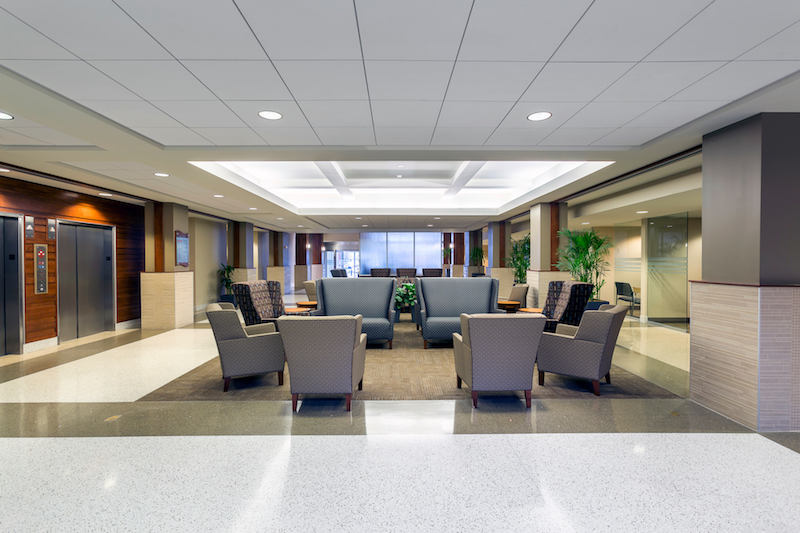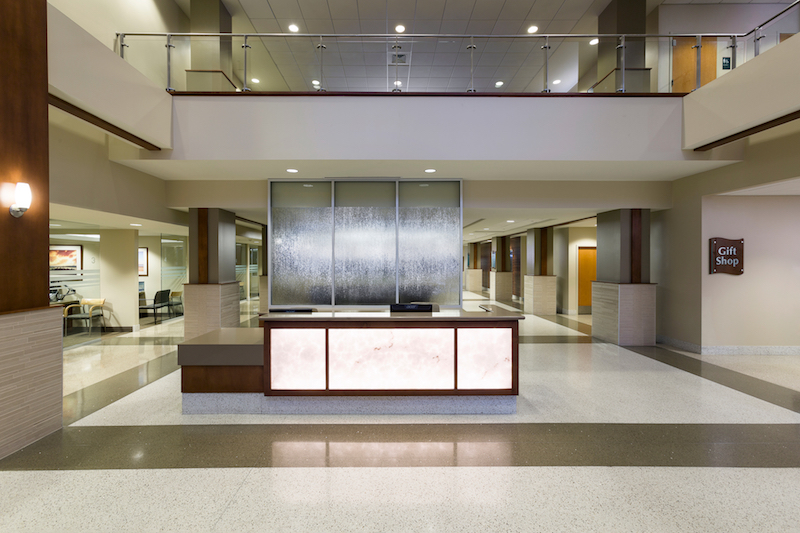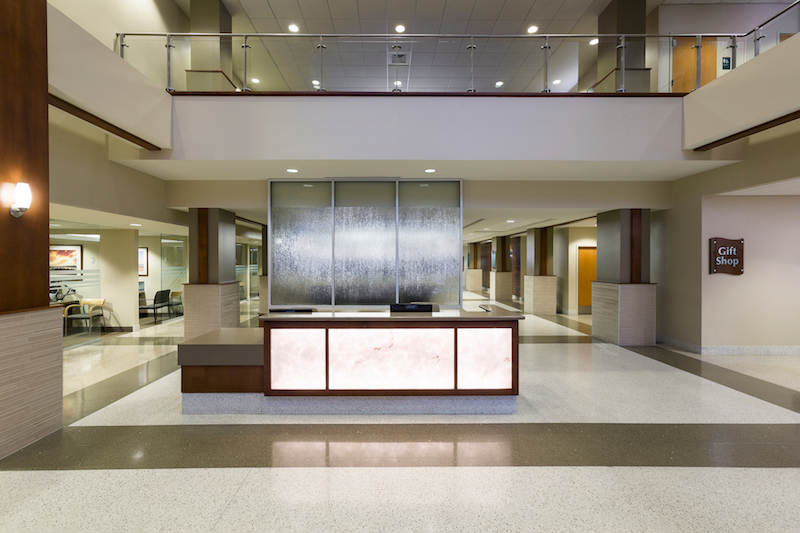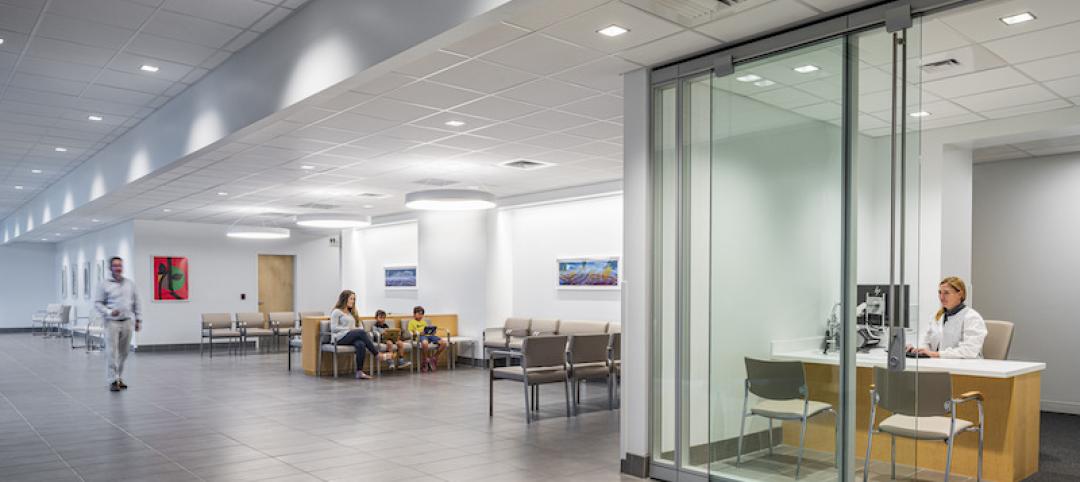Healthcare facilities offer a unique challenge for renovations due both to the rapid changes in technology and delivery of care, and also difficulty in preserving vital operations during construction. Often, the areas of the hospital that most urgently need upgrading are the ones that will be most difficult to relocate or temporarily shut-down. On occasion, the needed upgrades are so extreme that the hospital will build a replacement facility elsewhere to minimize the disruption to patient care, but many facilities must renovate within the existing footprint and seek creative ways to improve workflows and patient care delivery without building out.
Over the past decade, Flagler Hospital has been undergoing a complex, phased renovation touching every patient room and almost every public space with the aim of improving the patient experience. Hundreds of thousands of square feet and over twenty projects have been part of this on-going effort, all of which have been completed while the hospital sees patients 24/7.
 A new waiting area at Flagler Hospital features classic finishes and comfortable seating.
A new waiting area at Flagler Hospital features classic finishes and comfortable seating.
Importance of a Master Finish Plan for Project Success and to Control Scope Creep
Implementing a master finish plan and interior design concept was the secret to the project’s success. Even though particular elements of the design evolved over time, the result looks cohesive because of the thought that went into the long-term goal. The interior designers developed a template for public corridors, patient rooms, clinical space and staff areas that could be adapted for each phase of the renovations.
This comprehensive vision is key because many facilities, including Flagler Hospital, have a network of corridors without clear boundaries. The Owner and designers must establish priorities for the renovation and potentially decide to put off some of the work until a later date. With Flagler Hospital, contractors would implement the major projects and the hospital facilities department was able to execute “connecting” spaces. This hybrid approach allowed projects to remain on schedule and within budget, while still improving the public and patient areas.
For example, recently when renovating a major procedure room, the hospital had to weigh the options of leaving finishes in the corridors intact or going ahead and replacing the flooring. Unfortunately, the project scope impacted just a few dozen feet of the corridors, but there was no clear stopping point for many thousands of feet. The existing flooring in the corridors, which had been replaced as part of an earlier finish upgrade, had been discontinued. The facility also made the decision to switch from sheet vinyl as the main corridor flooring material to luxury vinyl tile. The team worked together to prioritize areas that should be upgraded immediately and was able to use attic stock to patch the existing flooring without creating an unattractive patchwork effect.
Choosing Materials Wisely to Reduce Downtime
The master finish plan also sets the precedent for material durability, quality and availability. Most renovations at Flagler Hospital, as well as other hospitals, have a lifespan of 10-15 years, therefore materials must have longevity in appearance and durability. For instance, solid surface is used for counters in high touch and patient care areas in this facility because it maintains its appearance longer than plastic laminate. In the lifespan of most projects, there will be a need for repair or minor renovation. It is important to select materials that are readily available, preferably made in the United States to reduce long lead times.
The impact of the materials on air quality is another factor to consider. Using low- or no-VOC materials whenever possible will minimize the effects of the renovation on an active clinical environment. No-wax floors will reduce fumes from stripping and waxing over the life of the project. At Flagler, terrazzo tiles were used to match terrazzo in the lobby and create a similar high-design look with much less disruption from dust and noise. Making compromises like this in phased, or fast-turnaround projects requires creativity and flexibility but can offer great results.
Additional considerations when selecting materials are infection prevention, acoustics, patient safety and aesthetics that meet the hospital’s mission and core values.
 The new lobby in Flagler is bright and welcoming and features durable materials.
The new lobby in Flagler is bright and welcoming and features durable materials.
Managing Patient and Staff Expectations
Managing the expectations of clients and staff is an important role for hospital facilities staff. After the planning meetings have concluded, the wise facilities team will continue to communicate the end goal internally and externally throughout the life of the project.
Construction tends to make things uncomfortable but providing staff with regular information and timing updates alleviates confusion and stress. Facilities should consider appointing a change management director to inform staff about the typical construction process, listen to concerns and ideas, and appoint ambassadors for the project below the administrative level. Feeling heard and understanding the short duration can help to smooth the transition during construction.
To communicate with patients, facilities should consider adding renderings and basic renovation details to the temporary dust barriers around the project site. Informed staff who can enthusiastically answer questions about the construction will also encourage positive sentiment amongst patients.
Although the design and facilities teams may have put a lot of thought in maintaining patient flow during the project phases, unexpected problems arise. Unknown as-built conditions create challenges that require prompt problem solving and flexible expectations. During renovations at Flagler, the Radiology, Cath Lab and Labor and Delivery reception desk was shifted to accommodate the new floor plan. While the desk was rebuilt, the radiology receptionist had to sit at a freestanding desk in the middle of the lobby complicating privacy and equipment security concerns.
Temporarily, the seating in the waiting area was more compressed causing problems with the mixed patient and guest populations. Many of the Radiology and Cath Lab patients were fasting before their procedures, but some guests in the lobby were simply waiting for extended periods for someone in Labor and Delivery—and eating while they waited. Using furniture, like high-back sofas, the team created separate sections within the large waiting area to create “rooms” for OB patients and their family members.
Enhanced Spaces
While renovations present unique challenges, particularly in hospital spaces that operate 24/7, they are necessary to elevate the human experience. However, managing renovations to minimize immediate impact to that experience is also critical. Outlining and committing to a plan and aligning on goals provides a strong foundation for a successful project. Smart materials selection and good communication help take projects to the next level resulting in more functional, appealing spaces that will stand the test of time.
More from Author
Gresham Smith | Aug 17, 2023
How to design for adaptive reuse: Don’t reinvent the wheel
Gresham Smith demonstrates the opportunities of adaptive reuse, specifically reusing empty big-box retail and malls, many of which sit unused or underutilized across the country.
Gresham Smith | May 24, 2023
Designing spaces that promote enrollment
Alyson Mandeville, Higher Education Practice Leader, argues that colleges and universities need to shift their business model—with the help of designers.
Gresham Smith | Apr 24, 2023
Smart savings: Commissioning for the hybrid workplace
Joe Crowe, Senior Mechanical Engineer, Gresham Smith, shares smart savings tips for facility managers and building owners of hybrid workplaces.
Gresham Smith | Mar 20, 2023
3 ways prefabrication doubles as a sustainability strategy
Corie Baker, AIA, shares three modular Gresham Smith projects that found sustainability benefits from the use of prefabrication.
Gresham Smith | Jan 19, 2023
Maximizing access for everyone: A closer look at universal design in healthcare facilities
Maria Sanchez, Interior Designer at Gresham Smith, shares how universal design bolsters empathy and equity in healthcare facilities.
Gresham Smith | Dec 20, 2022
Designing for a first-in-the-world proton therapy cancer treatment system
Gresham Smith begins designing four proton therapy vaults for a Flint, Mich., medical center.
Gresham Smith | Nov 21, 2022
An inside look at the airport industry's plan to develop a digital twin guidebook
Zoë Fisher, AIA explores how design strategies are changing the way we deliver and design projects in the post-pandemic world.
Gresham Smith | Feb 13, 2022
Helping maximize project dollars: Utility coordination 101
In this post, I take a look at the utility coordination services our Transportation group offers to our clients in an attempt to minimize delays and avoid unforeseen costs.
Gresham Smith | May 7, 2021
Private practice: Designing healthcare spaces that promote patient privacy
If a facility violates HIPAA rules, the penalty can be costly to both their reputation and wallet, with fines up to $250,000 depending on the severity.
Gresham Smith | Mar 4, 2021
Behavior mapping: Taking care of the caregivers through technology
Research suggests that the built environment may help reduce burnout.
















